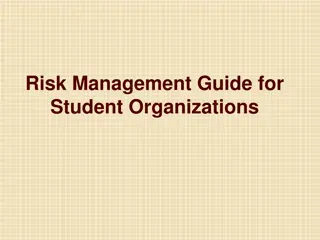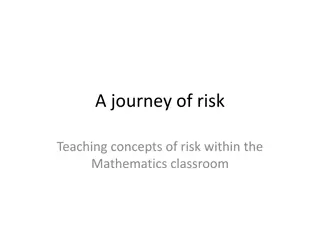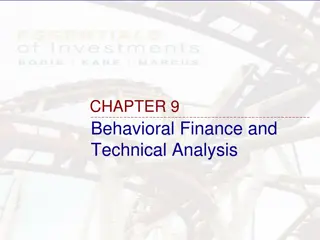Understanding Risk Concepts and Management Strategies in Finance
Explore the essential concepts of risk in finance, such as risk definition, risk profiles, financial exposure, and types of financial risks. Learn about risk vs. reward trade-offs, identifying risk profiles, and tools to control financial risk. Understand the balance between risk and return, and the different types of risks like business risk, credit risk, country risk, and foreign exchange risk.
Download Presentation

Please find below an Image/Link to download the presentation.
The content on the website is provided AS IS for your information and personal use only. It may not be sold, licensed, or shared on other websites without obtaining consent from the author. Download presentation by click this link. If you encounter any issues during the download, it is possible that the publisher has removed the file from their server.
E N D
Presentation Transcript
Risk Concepts and management strategies
Contents Risk Definition Risk Profile Financial Risk - types and evaluation Tools and measures to control financial risk Risk for Brokerage Firms - market and customers
Risk definition Possibility that an outcome or investment's actual gains will differ from an expected outcome or return. Includes the possibility of losing some or all of an original investment. It measures the uncertainty that an investor is willing to take to realize a gain
Risk vs. Reward Risk return tradeoff is the balance between the desire for lowest possible risk and highest possible return. Only a theoretical approach - high risk does not necessarily mean high return. Consider expected return and volatility compared to the rate of return
Risk Profile Risk profile identifies the level of risk an individual is willing and able to accept Willingness to accept risk: Risk-averse <-------> Risk-seeker Low risk High risk Low reward High reward Ability to take risk: higher the assets and lower the liabilities Willingness and ability to take risk may not align
How to identify Risk Profile? Profile questionnaire - individual s answers help to understand their risk tolerance Risk register: Illustrates risks and threats faced by an organization or individual. Includes probability of negative outcomes and potential costs and disruptions Possibility to proactively minimize risks
Risk = Financial Exposure The amount an investor stands to lose should the investment fail Gross exposure = sum of long and short positions Gross exposure indicates the percentage of the fund s assets that have been deployed and whether leverage (borrowed funds) have been used (if larger than 100%) Net exposure = long - short positions
Types of Financial Risk Risk can be systematic or unsystematic Business Risk - viability of business, if the sales can cover all operational costs and generate profit Credit or Default Risk - whether the borrower will be able to pay his debt obligations Country Risk - if the country is not able to honor its financial commitments Foreign-Exchange Risk - risk that changes in currency exchange rate will decrease the value of assets held in that currency Interest rate risk - decreasing investment value due to changes in interest rates Political Risk - effects of political instability or change in a country Counterparty Risk - the other party of the transaction might default on its contractual obligation Liquidity Risk - the ability to transact investment for cash
Systematic and unsystematic risk Systematic risk - associated with the market, unpredictable and undiversifiable (e.g. political upheaval affects bond, stocks and currency markets). Mitigated through hedging Unsystematic risk- associated with company or sector, inherent to specific company or sector. Mitigated through asset diversification
Risk Hedging Hedge is an investment made with the intention of reducing the risk of adverse price movements in an asset Eliminates risk by being inversely correlated to the vulnerable asset Derivatives: Options, swaps, futures and forward contracts Comes at a price to reduce risk, decreases potential profits
Tools to control Financial Risk Fundamental Analysis - measuring intrinsic value by evaluating underlying business, assets and earning Technical Analysis - evaluating through statistics of historical values. Quantitative Analysis - evaluating historical performance using specific financial ratio
Risk Measures Beta - systematic (market) risk measures volatility of an individual stock compared to the entire market Money manager can attempt to increase the portfolio risk by taking on more market risk (beta greater than 1) or decrease by taking on beta less than 1 Alpha - is a measure of excess return Active strategies include tactics that leverage stock, sector or country selection, fundamental analysis, position sizing, and technical analysis R-squared - correlation between the investment and benchmark (percentage- 80-100% high correlation, lower than 70% low correlation) Standard Deviation - data dispersion compared to mean value (volatility)
Risk Measures Capital Asset Pricing Model - equilibrium theory based on relationship between risk and expected return Efficient Frontiers - optimal level of diversification and asset allocation given the intrinsic risks of a portfolio Sharpe Ratio - measures performance as adjusted to the associated risk (adjusted rate of return divided by st. deviation) Sortino Ratio - removes the effects of upward price movements Treynor Ratio - uses beta (correlation) with the portfolio
Risk Measures Value at Risk (VaR) - the maximum potential loss with a degree of confidence for a specific period
Risk for Brokerage Firms Sources of risk in the Brokerage Business: Internal (failing to gain expected market share, compliance risks, credit risks) Competition risks (banks, other security traders, copied innovations, constraints on innovation) Loss of a favorable business environment (macroeconomic changes)
Risk Assessment of Customers nature of the customer (e.g., institutional or retail) and its corresponding level of experience and sophistication creditworthiness of the customer, as measured by established credit policies and procedures of the broker/intermediary authority (including apparent authority) of the customer to conduct its proposed trading activities, including the customer's legal authority and the capacity of the individuals responsible for the trading.
Management of customer risk Establishing margin requirements and position limits at adequate levels Reviewing significant market exposures at least daily Calling for additional collateral modifying margin requirements or position limits, reducing position size Identifying and protecting customer property in their custody Identifying cheating and arbitrage trading
References Risk Management For Broker-Dealers By Alan M. Wolper https://www.lockelord.com/- /media/files/newsandevents/news/2008/08/practical-compliance--risk-management-for-the-se__/files/wolper-risk- management/fileattachment/wolper_pcrm_03-08.pdf RISK MANAGEMENT AND CONTROL GUIDANCE FOR SECURITIES FIRMS AND THEIR SUPERVISORS https://www.iosco.org/library/pubdocs/pdf/IOSCOPD78.pdf A comprehensive review of value at risk methodologies https://www.elsevier.es/en-revista-the-spanish-review-financial- economics-332-articulo-a-comprehensive-review-value-at-S217312681300017X This wealth-tech startup helps Indians invest in Google, Amazon, Facebook, and other US stocks https://yourstory.com/2020/07/wealth-tech-startup-invest-google-amazon-facebook-usa-stocks Securities and risk http://www.versobank.com/description-of-securities-and-risks-related-to-securities-eng.pdf One of the disruptive factors that brokerages face these days is an increasing number of advanced traders who know how to outpace their brokerage and create toxic order flow. Arbitrage trading is a very modern trend, and we have skills in this area https://financefeeds.com/whats-the-cost-fx-dealing-desks-are-outmoded-full-report-from-moscow/























